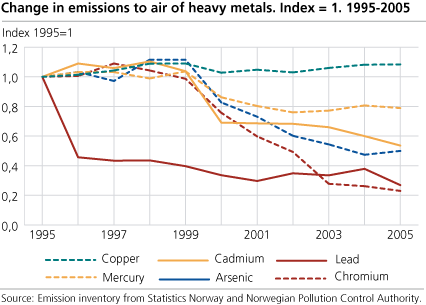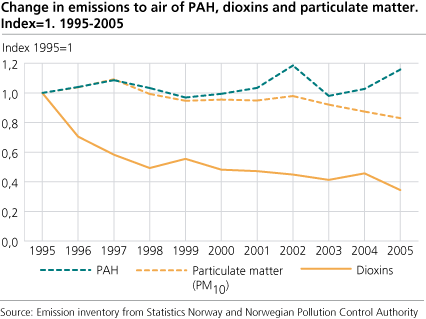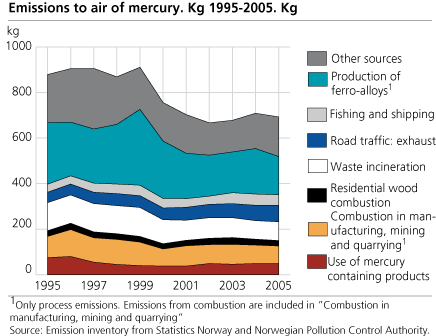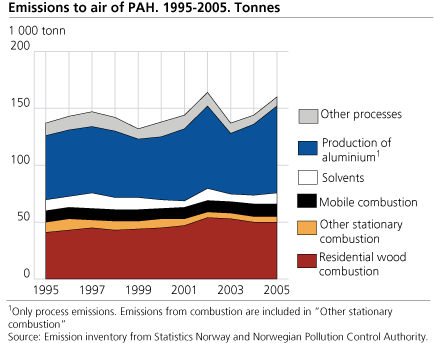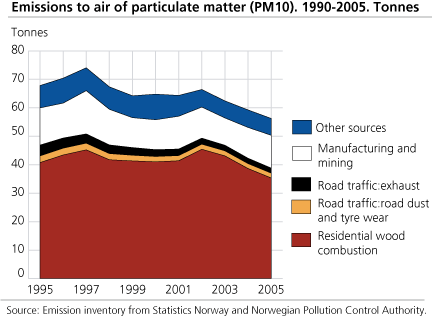Content
Published:
This is an archived release.
Reduced emissions of hazardous substances
Norwegian emissions to air of hazardous substances have been reduced considerably since 1995, in line with national targets and international obligations. Emissions of all heavy metals except arsenic and copper were reduced from 2004 to 2005. Emissions of dioxins and particulate matter also decreased, whereas emissions of PAH increased.
The figures presented here have been calculated by Statistics Norway (SSB) in collaboration with the Norwegian Pollution Control Authority (SFT).
The decline since 1995 is mainly due to reduced emissions in the manufacturing industries, which have been caused by improved treatment systems and manufacturing processes as well as lower activity in some industries. In addition, emissions of lead from road traffic have been dramatically reduced in the period 1990 to 1997 as leaded petrol has been phased out. In recent years, road traffic and use of fuelwood have accounted for a greater share of the total, a fact which results in less variation from one year to the next.
|
National and international obligations
Report No. 14 (2006-2007) to the Storting presents new national targets on reductions in emissions of hazardous substances by 2010 from the 1995 level. The report lists 25 substances/groups of substances of which emissions shall be eliminated or substantially reduced (50-90 per cent reduction). These reductions comprise emissions to air, water and earth, but the targets are not specified on each category. The figures presented in this article only include emissions to air. In various international agreements, Norway has committed to reduce its emissions to air of certain hazardous substances from the 1990 level. Different protocols under the Convention on Long-Range Transboundary Air Pollution (CLRTAP) set out the targets for emissions with regional effects. One of these protocols, the Aarhus Protocol, gives specific commitments for reduction of PAH and dioxins, lead, cadmium and mercury. For copper, chromium and arsenic, there are no commitments, but requirements for reporting of emissions. |
Mercury emissions reduced by more than 20 per cent since 1995
In 2005, national emissions to air of mercury were about 21 per cent lower than in 1995. The reduction can be explained by lower emissions from manufacture of ferro-alloys and waste incineration, due to improved equipment for emission control, and also by the closure of one chemical plant. Emissions from use of products (e.g. mercury thermometers) have been reduced, but the use of cars with diesel engines has caused a 57 per cent rise in emissions from this source since 1995.
In 2005, mercury emissions to the atmosphere totalled 693 kg. Emissions from road traffic rose by 8 per cent from 2004, due to increased use of diesel cars. In the manufacture of metals, lower mercury contents in the raw materials led to reduced total emissions of mercury compared with 2004.
Process emissions from manufacturing industries caused about 35 per cent of the mercury emissions in 2005. Road traffic, coastal shipping and other mobile combustion accounted for 26 per cent, waste incineration 11 per cent, use of fuelwood 15 per cent, and use of products 7 per cent.
The environmental authorities now propose strict rules against mercury in products. Long-range transport of mercury from Asia, North America and Europe causes a serious problem in the Arctic region.
Increased emissions of PAH
Emissions of PAH (Polycyclic Aromatic Hydrocarbons) totalled 160 tonnes in 2005. This is a 17 per cent growth from 1995 and 12 per cent higher than in 2004. The main sources are aluminium production and use of fuelwood. PAH emissions from domestic use of fuelwood have increased by 22 per cent since 1995, and this source contributes with more than 30 per cent of the total.
Lower emissions of particulate matter
In 2005, emissions of particulate matter (PM10) to air totalled 56 300 tonnes. This is 5 per cent lower than in 2004. Nearly two thirds, or 35 400 tonnes, originated from fuelwood use. Manufacturing industries and mining accounted for 20 per cent of the emissions in 2005. Emissions of particulate matter have been reduced by 17 per cent since 1995.
|
Emissions of particulate matter from fuelwood use
A survey carried out by Statistics Norway shows that one of the reasons for high emissions from fuelwood use is that 63 per cent of the wood is burned in old wood-burning stoves produced before 1998. These stoves are estimated to emit 5-6 times more particulate matter than new stoves. 34 per cent of the wood is burned in new stoves, which is a 16 percentage points increase from 2002. |
|
Local emissions to air
Particulate matter (PM1 0) and nitrogen oxides (NOX) are the main pollutants affecting local air quality in many places in Norway. Fuelwood use, exhaust from road traffic and road dust are the most important sources. Emissions and local air quality There are important differences between emissions to air and local air quality. The figures presented here cover emissions to air, i.e. the amount of particulate matter that comes out of the chimney or the exhaust pipe. Different emission sources contribute to the concentration of harmful substances in the air. The concentration of the gas/particulate matter is important when determining whether the gas/particulate matter is dangerous to inhale. When calculating the concentrations, one must take into account that the emissions from fuelwood use are emitted from high chimneys, while exhaust from cars and road dust is emitted near the ground. Emissions from the use of fuelwood will be more diluted than road dust before people inhale it. Therefore, a tonne of particulate matter from fuelwood use may have less effect on the ground level concentration than a tonne of exhaust and road dust. |
Uncertainties
The emission data are calculated by Statistics Norway in cooperation with the Norwegian Pollution Control Authority. They are based on measurements from large industrial plants and combustion plants, combined with calculations based on activity data and emission factors. Considerable uncertainty is attached to the statistics for heavy metals and persistent organic pollutants, mainly due to variations in reported emission data. These sometimes vary substantially from year to year, although the actual emissions may be at the same level; thus an evaluation of whether it is reasonable to use the reported figures or not, is necessary.
Recalculations
According to guidelines for reporting of emission data, the Norwegian emission inventory is recalculated annually for every year back to 1990 in order to report as consistent time series as possible. New knowledge on emission factors, activity data, new emission sources or improved calculation methods are then taken into account.
Documentation of the Norwegian emission inventory
Statistics Norway publishes a new documentation report of the Norwegian emission inventory every year. The report describes calculation methods, documents the activity data, emission factors and the data sources used in the calculations. Quality controls and uncertainty calculations are also described in the report. The report is used as a basis in Norway’s annual emission reports to the United Nation Framework Convention on Climate Change (UNFCCC). Download the last edition of the report here .
State of the Environment Norway has information about health and environmental effects of heavy metals.
Other articles published today
21 per cent cut in NOX emissions required by 2010 .
Temporary reduction in emissions of greenhouse gases
More figures in StatBank .
Tables:
The statistics is published with Emissions to air.
Contact
-
Statistics Norway's Information Centre
E-mail: informasjon@ssb.no
tel.: (+47) 21 09 46 42

